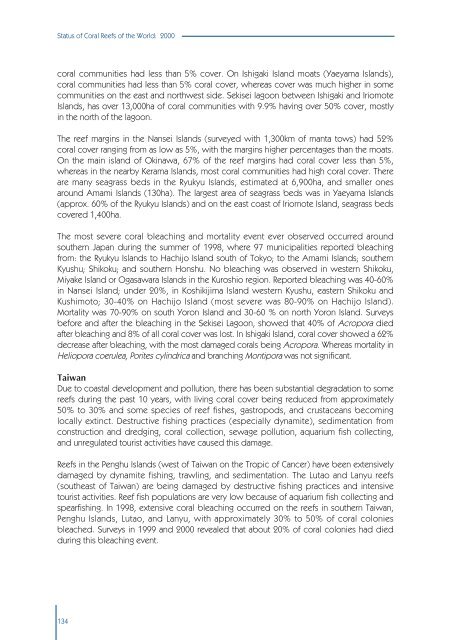Status of Coral Reefs of the World 2000
Status of Coral Reefs of the World 2000.pdf
Status of Coral Reefs of the World 2000.pdf
- No tags were found...
Create successful ePaper yourself
Turn your PDF publications into a flip-book with our unique Google optimized e-Paper software.
<strong>Status</strong> <strong>of</strong> <strong>Coral</strong> <strong>Reefs</strong> <strong>of</strong> <strong>the</strong> <strong>World</strong>: <strong>2000</strong><br />
coral communities had less than 5% cover. On Ishigaki Island moats (Yaeyama Islands),<br />
coral communities had less than 5% coral cover, whereas cover was much higher in some<br />
communities on <strong>the</strong> east and northwest side. Sekisei lagoon between Ishigaki and Iriomote<br />
Islands, has over 13,000ha <strong>of</strong> coral communities with 9.9% having over 50% cover, mostly<br />
in <strong>the</strong> north <strong>of</strong> <strong>the</strong> lagoon.<br />
The reef margins in <strong>the</strong> Nansei Islands (surveyed with 1,300km <strong>of</strong> manta tows) had 52%<br />
coral cover ranging from as low as 5%, with <strong>the</strong> margins higher percentages than <strong>the</strong> moats.<br />
On <strong>the</strong> main island <strong>of</strong> Okinawa, 67% <strong>of</strong> <strong>the</strong> reef margins had coral cover less than 5%,<br />
whereas in <strong>the</strong> nearby Kerama Islands, most coral communities had high coral cover. There<br />
are many seagrass beds in <strong>the</strong> Ryukyu Islands, estimated at 6,900ha, and smaller ones<br />
around Amami Islands (130ha). The largest area <strong>of</strong> seagrass beds was in Yaeyama Islands<br />
(approx. 60% <strong>of</strong> <strong>the</strong> Ryukyu Islands) and on <strong>the</strong> east coast <strong>of</strong> Iriomote Island, seagrass beds<br />
covered 1,400ha.<br />
The most severe coral bleaching and mortality event ever observed occurred around<br />
sou<strong>the</strong>rn Japan during <strong>the</strong> summer <strong>of</strong> 1998, where 97 municipalities reported bleaching<br />
from: <strong>the</strong> Ryukyu Islands to Hachijo Island south <strong>of</strong> Tokyo; to <strong>the</strong> Amami Islands; sou<strong>the</strong>rn<br />
Kyushu; Shikoku; and sou<strong>the</strong>rn Honshu. No bleaching was observed in western Shikoku,<br />
Miyake Island or Ogasawara Islands in <strong>the</strong> Kuroshio region. Reported bleaching was 40-60%<br />
in Nansei Island; under 20%, in Koshikijima Island western Kyushu, eastern Shikoku and<br />
Kushimoto; 30-40% on Hachijo Island (most severe was 80-90% on Hachijo Island).<br />
Mortality was 70-90% on south Yoron Island and 30-60 % on north Yoron Island. Surveys<br />
before and after <strong>the</strong> bleaching in <strong>the</strong> Sekisei Lagoon, showed that 40% <strong>of</strong> Acropora died<br />
after bleaching and 8% <strong>of</strong> all coral cover was lost. In Ishigaki Island, coral cover showed a 62%<br />
decrease after bleaching, with <strong>the</strong> most damaged corals being Acropora. Whereas mortality in<br />
Heliopora coerulea, Porites cylindrica and branching Montipora was not significant.<br />
Taiwan<br />
Due to coastal development and pollution, <strong>the</strong>re has been substantial degradation to some<br />
reefs during <strong>the</strong> past 10 years, with living coral cover being reduced from approximately<br />
50% to 30% and some species <strong>of</strong> reef fishes, gastropods, and crustaceans becoming<br />
locally extinct. Destructive fishing practices (especially dynamite), sedimentation from<br />
construction and dredging, coral collection, sewage pollution, aquarium fish collecting,<br />
and unregulated tourist activities have caused this damage.<br />
<strong>Reefs</strong> in <strong>the</strong> Penghu Islands (west <strong>of</strong> Taiwan on <strong>the</strong> Tropic <strong>of</strong> Cancer) have been extensively<br />
damaged by dynamite fishing, trawling, and sedimentation. The Lutao and Lanyu reefs<br />
(sou<strong>the</strong>ast <strong>of</strong> Taiwan) are being damaged by destructive fishing practices and intensive<br />
tourist activities. Reef fish populations are very low because <strong>of</strong> aquarium fish collecting and<br />
spearfishing. In 1998, extensive coral bleaching occurred on <strong>the</strong> reefs in sou<strong>the</strong>rn Taiwan,<br />
Penghu Islands, Lutao, and Lanyu, with approximately 30% to 50% <strong>of</strong> coral colonies<br />
bleached. Surveys in 1999 and <strong>2000</strong> revealed that about 20% <strong>of</strong> coral colonies had died<br />
during this bleaching event.<br />
134
















